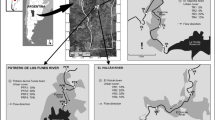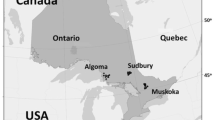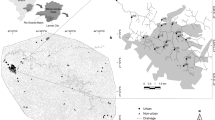Abstract
Anuran amphibians are highly dependent on aquatic ecosystems. Many amphibian species are exhibiting population declines primarily due to habitat destruction and water quality degradation as a result of urban expansion. The objective of this study was to examine combined effects of habitat degradation and water quality on amphibian assemblages in rivers affected by urban impacts. Twelve sites along three rivers were characterized in regard to urbanization and habitat condition using the calculation of a Habitat Model Affinity (HMA) score. Fifteen water quality parameters were assessed at each site. A Simplified Index of Water Quality (SIWQ) and a general Water Quality Index (WQI) were applied. Species richness and relative abundance of amphibians were estimated from visual encounter and calling surveys during summer season between 2009 and 2013. Species richness and abundance were negatively correlated with phosphate, nitrate concentrations and total coliforms, and positively correlated with HMA, electrical conductivity and dissolved oxygen. Species richness was also affected negatively by turbidity. Principal component analysis showed that sites with higher amphibian community metrics were also the ones with lower nutrient levels and better habitat conditions. This study identified important water quality parameters affecting amphibians in rivers with increasing urban impact; and provides information that can be used in the design of strategies to minimize the impacts of urbanization on aquatic biodiversity.




Similar content being viewed by others
References
Agüero NS, Moglia MM, Jofré MB (2010) ¿Se relaciona el patrón de abundancia y distribución de anuros con la estructura de las comunidades de plantas en hábitats acuáticos de la ciudad de San Luis (Argentina)? Neotrop Biol Conserv 5(2)
Almeida CA, Quintar S, González P, Mallea MA (2007) Influence of urbanization and tourist activities on the water quality of the Potrero de los Funes River (San Luis–Argentina). Environ Monit Assess 133:459–465
Almeida C, González SO, Mallea M, González P (2012) A recreational water quality index using chemical, physical and microbiological parameters. Environ Sci Pollut Res 19:3400–3411
American Public Health Association - APHA (2005) Standard methods for the examination of water and wastewater, 21st edn. American Public Health Association, Washington DC, pp 1220
Babini MS, de Lourdes BC, Salinas ZA et al (2018) Reproductive endpoints of Rhinella arenarum (Anura, Bufonidae): populations that persist in agroecosystems and their use for the environmental health assessment. Ecotoxicol Environ Saf 154:294–301
Bagur M, Morales S, López-Chicano M (2009) Evaluation of the environmental contamination at an abandoned mining site using multivariate statistical techniques—the Rodalquilar (Southern Spain) mining district. Talanta 80:377–384
Baldwin RF, Calhoun AJ, deMaynadier PG (2006) Conservation planning for amphibian species with complex habitat requirements: a case study using movements and habitat selection of the wood frog Rana sylvatica. J Herpetol 40:442–453
Barbour MT, Gerritsen J, Snyder BD et al (1999) Rapid bioassessment protocols for use in streams and wadeable rivers: periphyton, benthic macroinvertebrates and fish. US Environmental Protection Agency, Office of Water Washington, DC
Barrett K, Helms BS, Guyer C, Schoonover JE (2010) Linking process to pattern: causes of stream-breeding amphibian decline in urbanized watersheds. Biol Conserv 143:1998–2005
Berger L, Roberts AA, Voyles J, Longcore JE, Murray KA, Skerratt LF (2016) History and recent progress on chytridiomycosis in amphibians. Fungal Ecol 19:89–99
Bernal MH, Alton LA, Cramp RL, Franklin CE (2011) Does simultaneous UV-B exposure enhance the lethal and sub-lethal effects of aquatic hypoxia on developing anuran embryos and larvae? J Comp Physiol B 181:973–980
Blaustein AR, Romansic JM, Kiesecker JM (2003) Ultraviolet radiation, toxic chemicals and amphibian population declines. Divers Distrib 9:123–140
Boyer R, Grue CE (1995) The need for water quality criteria for frogs. Environ Health Perspect 103:352–357
Broggi Colman G, Bellagamba J (2006) Calidad de agua de cursos en el Uruguay y análisis de normativa vigente. Congreso Interamericano de Ingeniería Sanitaria y Ambiental, 30. AIDIS, pp. 1-11
Calderon MR, González P, Moglia M, Oliva Gonzáles S, Jofré M (2014) Use of multiple indicators to assess the environmental quality of urbanized aquatic surroundings in San Luis, Argentina. Environ Monit Assess 186:4411–4422
Calderon M, Moglia M, Nievas R et al (2017) Assessment of the environmental quality of two urbanized lotic systems using multiple indicators. River Res Appl 33:1119–1129
Camargo JA, Alonso A, De La Puente M (2004) Multimetric assessment of nutrient enrichment in impounded rivers based on benthic macroinvertebrates. Environ Monit Assess 96:233–249
Camargo JA, Alonso A, Salamanca A (2005) Nitrate toxicity to aquatic animals: a review with new data for freshwater invertebrates. Chemosphere 58:1255–1267
Canals RM, Ferrer V, Iriarte A, Cárcamo S, Emeterio LS, Villanueva E (2011) Emerging conflicts for the environmental use of water in high-valuable rangelands. Can livestock water ponds be managed as artificial wetlands for amphibians? Ecol Eng 37:1443–1452
Carey C, Bryant CJ (1995) Possible interrelations among environmental toxicants, amphibian development, and decline of amphibian populations. Environ Health Perspect 103:13
Carr JA (2011) Stress and reproduction in amphibians. Amphibians. Elsevier, Hormones and Reproduction of Vertebrates, pp 99–116
Carr JA, Patiño R (2011) The hypothalamus–pituitary–thyroid axis in teleosts and amphibians: endocrine disruption and its consequences to natural populations. Gen Comp Endocrinol 170:299–312
Castaneda AJ (2014) The effects of water and habitat quality on amphibian assemblages in agricultural ditches. Doctoral dissertation, Purdue University. Accessed in: https://pdfs.semanticscholar.org/ee88/e5372e1c48bce4f544b1b8161c2925b294a0.pdf. Accessed April 2019
Chambers DL (2011) Increased conductivity affects corticosterone levels and prey consumption in larval amphibians. J Herpetol 45:219–223
Chen J, Theller L, Gitau MW, Engel BA, Harbor JM (2017) Urbanization impacts on surface runoff of the contiguous United States. J Environ Manag 187:470–481
Chica-Olmo M, Carpintero-Salvo I, García-Soldado M et al (2005) Una aproximación geoestadística al análisis espacial de la calidad del agua subterránea. GeoFocus Revista Internacional de Ciencia y Tecnología de la Información Geográfica:79–93
Cude CG (2001) Oregon water quality index a tool for evaluating water quality management effectiveness. J Am Water Res Assoc 37:125–137
Cushman SA (2006) Effects of habitat loss and fragmentation on amphibians: a review and prospectus. Biol Conserv 128:231–240
Davidson C, Shaffer HB, Jennings MR (2002) Spatial tests of the pesticide drift, habitat destruction, UV-B, and climate-change hypotheses for California amphibian declines. Conserv Biol 16:1588–1601
de Solla SR, Bishop CA, Pettit KE, Elliott JE (2002a) Organochlorine pesticides and polychlorinated biphenyls (PCBs) in eggs of red-legged frogs (Rana aurora) and northwestern salamanders (Ambystoma gracile) in an agricultural landscape. Chemosphere 46:1027–1032
de Solla SR, Pettit KE, Bishop CA, Cheng KM, Elliott JE (2002b) Effects of agricultural runoff on native amphibians in the lower Fraser River Valley, British Columbia, Canada. Environ Toxicol Chem 21:353–360
Dodd CK (2010) Amphibian ecology and conservation: a handbook of techniques. Oxford University Press
Duellman W, Trueb L (1994) Biology of amphibians –John Hopkins University press. Baltimore, London
Earl JE, Whiteman HH (2009) Effects of pulsed nitrate exposure on amphibian development. Environ Toxicol Chem 28:1331–1337
Fabricius KE, Cooper TF, Humphrey C, Uthicke S, de’ath G, Davidson J, LeGrand H, Thompson A, Schaffelke B (2012) A bioindicator system for water quality on inshore coral reefs of the great barrier reef. Mar Pollut Bull 65:320–332
Garcia-Gonzalez C, Garcia-Vazquez E (2012) Urban ponds, neglected Noah's ark for amphibians. J Herpetol 46:507–514
González SO, Almeida C, Calderón M et al (2014) Assessment of the water self-purification capacity on a river affected by organic pollution: application of chemometrics in spatial and temporal variations. Environ Sci Pollut Res 21:10583–10593
Gray MJ, Miller DL, Hoverman JT (2009) Ecology and pathology of amphibian ranaviruses. Dis Aquat Org 87:243–266
Hamer AJ, McDonnell MJ (2008) Amphibian ecology and conservation in the urbanising world: a review. Biol Conserv 141:2432–2449
Hamer AJ, Makings JA, Lane SJ, Mahony MJ (2004) Amphibian decline and fertilizers used on agricultural land in South-Eastern Australia. Agric Ecosyst Environ 102:299–305
Hatch AC, Blaustein AR (2000) Combined effects of UV-B, nitrate, and low pH reduce the survival and activity level of larval cascades frogs (Rana cascadae). Arch Environ Contam Toxicol 39:494–499
Helena B, Pardo R, Vega M, Barrado E, Fernandez JM, Fernandez L (2000) Temporal evolution of groundwater composition in an alluvial aquifer (Pisuerga River, Spain) by principal component analysis. Water Res 34(3):807–816
Helms BS, Feminella JW, Pan S (2005) Detection of biotic responses to urbanization using fish assemblages from small streams of western Georgia, USA. Urban Ecosystems 8:39–57
Henley W, Patterson M, Neves R et al (2000) Effects of sedimentation and turbidity on lotic food webs: a concise review for natural resource managers. Rev Fish Sci 8:125–139
Jofré MB, Cid FD, Caviedes-Vidal E (2010) Spatial and temporal patterns of richness and abundance in the anuran assemblage of an artificial water reservoir from the semiarid central region of Argentina. Amphibia-Reptilia 31:533–540
Jones B, Snodgrass JW, Ownby DR (2015) Relative toxicity of NaCl and road deicing salt to developing amphibians. Copeia 2015:72–77
Karr JR (1991) Biological integrity: a long-neglected aspect of water resource management. Ecol Appl 1:66–84
Karraker NE (2007) Are embryonic and larval green frogs (Rana clamitans) insensitive to road deicing salt? Biology, Herpetological Conservation and
Karraker NE, Gibbs JP, Vonesh JR (2008) Impacts of road deicing salt on the demography of vernal pool-breeding amphibians. Ecol Appl 18:724–734
Klaver RW, Peterson CR, Patla DA (2013) Influence of water conductivity on amphibian occupancy in the greater Yellowstone ecosystem. Western North American Naturalist 73:184–197
Krishnamurthy S, Meenakumari D, Gurushankara H et al (2006) Effects of nitrate on feeding and resting of tadpoles of Nyctibatrachus major (Anura: Ranidae). Aust J Ecotoxicol 12:123–127
Kupferberg SJ, Lind AJ, Thill V, Yarnell SM (2011) Water velocity tolerance in tadpoles of the foothill yellow-legged frog (Rana boylii): swimming performance, growth, and survival. Copeia 2011:141–152
Laposata MM, Dunson WA (2000) Effects of spray-irrigated wastewater effluent on temporary pond-breeding amphibians. Ecotoxicol Environ Saf 46:192–201
Lescano JN, Nori J, Verga E et al (2015) Anfibios de las Sierras Pampeanas Centrales de Argentina: diversidad y distribución altitudinal. Cuadernos de herpetología 29:103–115
Lloyd DS (1987) Turbidity as a water quality standard for salmonid habitats in Alaska. N Am J Fish Manag 7:34–45
Marco A, Quilchano C, Blaustein AR (1999) Sensitivity to nitrate and nitrite in pond-breeding amphibians from the Pacific Northwest, USA. Environ Toxicol Chem 18:2836–2839
Marian MP, Sampath K, Nirmala A et al (1980) Behavioural response of Rana cyanophylictis tadpole exposed to changes in dissolved oxygen concentration. Physiol Behav 25:35–38
Martel A, Spitzen-van der Sluijs A, Blooi M, Bert W, Ducatelle R, Fisher MC, Woeltjes A, Bosman W, Chiers K, Bossuyt F, Pasmans F (2013) Batrachochytrium salamandrivorans sp. nov. causes lethal chytridiomycosis in amphibians. Proc Natl Acad Sci 110:15325–15329
McKibbin R, Dushenko WT, Bishop CA (2008) The influence of water quality on the embryonic survivorship of the Oregon spotted frog (Rana pretiosa) in British Columbia, Canada. Sci Total Environ 395:28–40
McKinney ML (2008) Effects of urbanization on species richness: a review of plants and animals. Urban Ecosystems 11:161–176
Miller JD, Kim H, Kjeldsen TR, Packman J, Grebby S, Dearden R (2014) Assessing the impact of urbanization on storm runoff in a peri-urban catchment using historical change in impervious cover. J Hydrol 515:59–70
Mingo Magro J (1981) La vigilancia de la contaminación fluvial. MOPU, Madrid
Moore IT, Jessop TS (2003) Stress, reproduction, and adrenocortical modulation in amphibians and reptiles. Horm Behav 43:39–47
Morin PJ (1981) Predatory salamanders reverse the outcome of competition among three species of anuran tadpoles. Science 212:1284–1286
Morin PJ (1983) Predation, competition, and the composition of larval anuran guilds. Ecol Monogr 53:119–138
Noland R, Ultsch GR (1981) The roles of temperature and dissolved oxygen in microhabitat selection by the tadpoles of a frog (Rana pipiens) and a toad (Bufo terrestris). Copeia, 645–652
Olson DH, Aanensen DM, Ronnenberg KL, Powell CI, Walker SF, Bielby J, Garner TWJ, Weaver G, The Bd Mapping Group, Fisher MC (2013) Mapping the global emergence of Batrachochytrium dendrobatidis, the amphibian chytrid fungus. PLoS One 8:e56802
Oromí N, Sanuy D, Vilches M (2009) Effects of nitrate and ammonium on larvae of Rana temporaria from the Pyrenees. Bull Environ Contam Toxicol 82:534–537
Ortiz ME, Marco A, Saiz N et al (2004) Impact of ammonium nitrate on growth and survival of six European amphibians. Arch Environ Contam Toxicol 47:234–239
Ortiz-Santaliestra ME, Marco A, Fernández MJ, Lizana M (2006) Influence of developmental stage on sensitivity to ammonium nitrate of aquatic stages of amphibians. Environ Toxicol Chem 25:105–111
Pillsbury FC, Miller JR (2008) Habitat and landscape characteristics underlying anuran community structure along an urban–rural gradient. Ecol Appl 18:1107–1118
Porej D, Micacchion M, Hetherington TE (2004) Core terrestrial habitat for conservation of local populations of salamanders and wood frogs in agricultural landscapes. Biol Conserv 120:399–409
Pounds JA, Bustamante MR, Coloma LA et al (2006) Widespread amphibian extinctions from epidemic disease driven by global warming. Nature 439:161–167
Queralt R (1982) La calidad de las aguas en los rios. Tecnologia del agua, 4:49–57
Riley SP, Busteed GT, Kats LB et al (2005) Effects of urbanization on the distribution and abundance of amphibians and invasive species in southern California streams. Conserv Biol 19:1894–1907
Rollins-Smith LA (2009) The role of amphibian antimicrobial peptides in protection of amphibians from pathogens linked to global amphibian declines. Biochim Biophys Acta Biomembr 1788:1593–1599
Rouse JD, Bishop CA, Struger J (1999) Nitrogen pollution: an assessment of its threat to amphibian survival. Environ Health Perspect 107:799–803
Rowe DK, Dean TL, Williams E, Smith JP (2003) Effects of turbidity on the ability of juvenile rainbow trout, Oncorhynchus mykiss, to feed on limnetic and benthic prey in laboratory tanks. N Z J Mar Freshw Res 37:45–52
Rubbo MJ, Kiesecker JM (2005) Amphibian breeding distribution in an urbanized landscape. Conserv Biol 19:504–511
Schmutzer AC, Gray MJ, Burton EC et al (2008) Impacts of cattle on amphibian larvae and the aquatic environment. Freshw Biol 53:2613–2625
Semlitsch RD (2000) Principles for management of aquatic-breeding amphibians. J Wildl Manag 64:615–631
Seymour RS, Roberts JD, Mitchell NJ, Blaylock AJ (2000) Influence of environmental oxygen on development and hatching of aquatic eggs of the Australian frog, Crinia georgiana. Physiol Biochem Zool 73:501–507
Skerratt LF, Berger L, Speare R, Cashins S, McDonald KR, Phillott AD, Hines HB, Kenyon N (2007) Spread of chytridiomycosis has caused the rapid global decline and extinction of frogs. EcoHealth 4:125–134
Smith G, Temple K, Vaala D et al (2005) Effects of nitrate on the tadpoles of two Ranids (Rana catesbeiana and R. clamitans). Arch Environ Contam Toxicol 49:559–562
Sowers AD, Mills MA, Klaine SJ (2009) The developmental effects of a municipal wastewater effluent on the northern leopard frog, Rana pipiens. Aquat Toxicol 94:145–152
Sparling DW (2010) Water-quality criteria for amphibians. Amphibians Ecology and Conservation (CD Kenneth, ed.). Oxford University Press, USA 105–117
Stebbins RC, Cohen NW (1997) A natural history of amphibians. Princeton University Press, New Jersey, p 316
Suh D (2016) The impact of turbidity on the predator-prey relationship between red swamp crayfish (Procambarus clarkii) and pacific tree frog (Pseudacris regilla) tadpoles
Taebi A, Droste RL (2004) Pollution loads in urban runoff and sanitary wastewater. Sci Total Environ 327:175–184
Turtle SL (2000) Embryonic survivorship of the spotted salamander (Ambystoma maculatum) in roadside and woodland vernal pools in southeastern New Hampshire. J Herpetol, 60–67
Viertel B (1999) Salt tolerance of Rana temporaria: spawning site selection and survival during embryonic development (Amphibia, Anura). Amphibia-Reptilia 20:161–171
Villegas Ojeda MA, Andrea Espeche B, Jofré MB (2016) Desarrollo larval de anfibios anuros en un río impactado por urbanización: efecto de factores ambientales. Neotropical Biology & Conservation 11
Walsh CJ, Roy AH, Feminella JW, Cottingham PD, Groffman PM, Morgan RP II (2005) The urban stream syndrome: current knowledge and the search for a cure. J N Am Benthol Soc 24:706–723
Warkentin KM (2002) Hatching timing, oxygen availability, and external gill regression in the tree frog, Agalychnis callidryas. Physiol Biochem Zool 75:155–164
Wassersug RJ, Seibert EA (1975) Behavioral responses of amphibian larvae to variation in dissolved oxygen. Copeia 86–103
Weir L, Mossman M (2005) North American amphibian monitoring program (NAAMP)
Welsh HH, Ollivier LM (1998) Stream amphibians as indicators of ecosystem stress: a case study from California’s redwoods. Ecol Appl 8:1118–1132
Zhou F, Huang GH, Guo H, Zhang W, Hao Z (2007) Spatio-temporal patterns and source apportionment of coastal water pollution in eastern Hong Kong. Water Res 41:3429–3439
Zhu B, Wang T, Kuang FH, Luo ZX, Tang JL, Xu TP (2009) Measurements of nitrate leaching from a hillslope cropland in the Central Sichuan Basin, China. Soil Sci Soc Am J 73:1419–1426
Acknowledgements
Authors gratefully acknowledge Instituto de Química de San Luis “Dr. Roberto Olsina”- Consejo Nacional de Investigaciones Científicas y Tecnológicas (INQUISAL-CONICET) and Universidad Nacional de San Luis (Project PROICO 2-1914) for financial support. We thank MSc. Angela Stires for the valuable language and grammar revision of the manuscript.
Author information
Authors and Affiliations
Corresponding author
Rights and permissions
About this article
Cite this article
Calderon, M.R., Almeida, C.A., González, P. et al. Influence of water quality and habitat conditions on amphibian community metrics in rivers affected by urban activity. Urban Ecosyst 22, 743–755 (2019). https://doi.org/10.1007/s11252-019-00862-w
Published:
Issue Date:
DOI: https://doi.org/10.1007/s11252-019-00862-w




